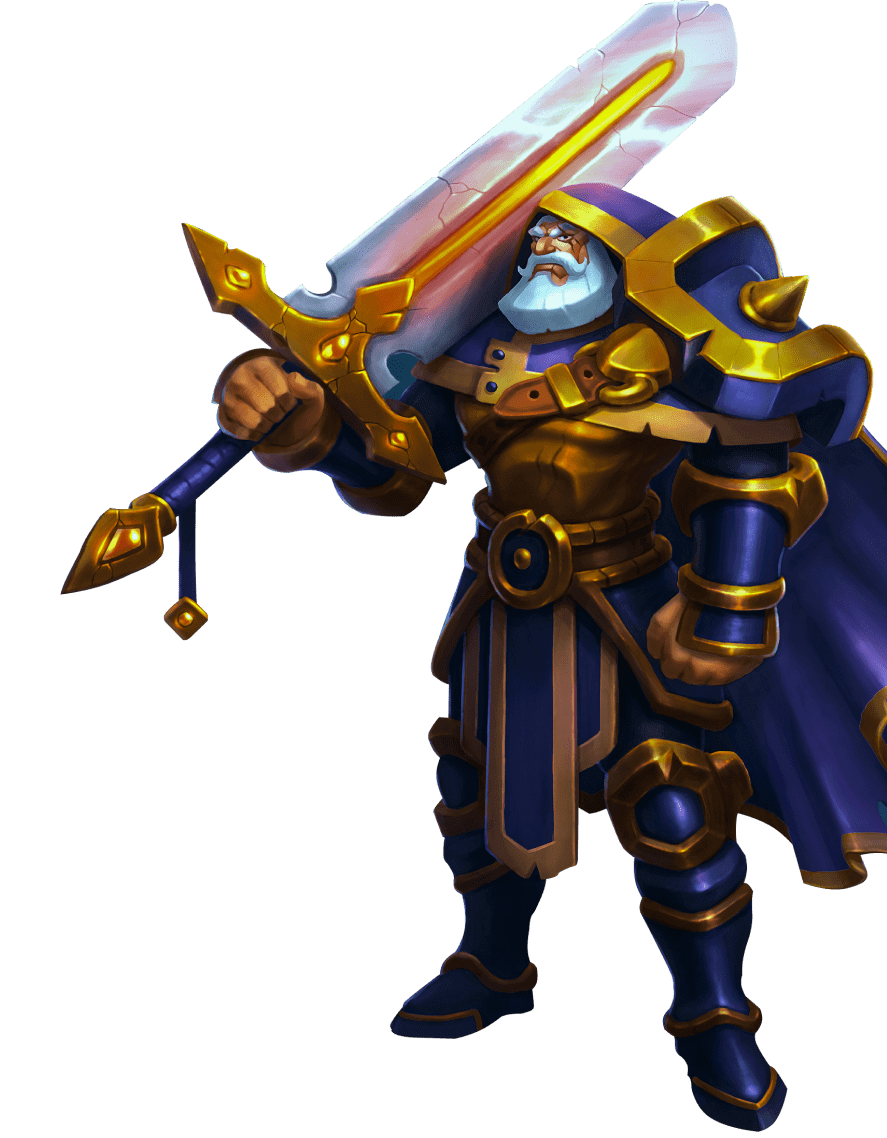It’s impossible to build a house without a blueprint. Similarly, developing a game without a Game Design Document (GDD) can lead to confusion and inefficiencies. Learning how to make a game design document is crucial, as it serves as the blueprint, the master plan, for your game development process, outlining the designer’s vision and ensuring a shared understanding among team members.

Understanding the Game Design Document
Any game project considers a GDD its linchpin, as this dynamic document navigates the development team through the game design process. It is a technical and descriptive document that provides detailed descriptions of game elements, ensuring everyone involved in the game project is on the same page.
Flowcharts, maps, and other visual representations are significant in a GDD. Some examples include:
- Flowcharts, which illustrate user interface (UI) designs;
- Maps, which represent game levels;
- Graph charts plot project timelines, conveying start and end dates of different stages.
Importantly, making the GDD enjoyable to read increases its utility. An engaging document is more likely to serve as a starting point for the game’s development, referenced and adhered to by the development team.
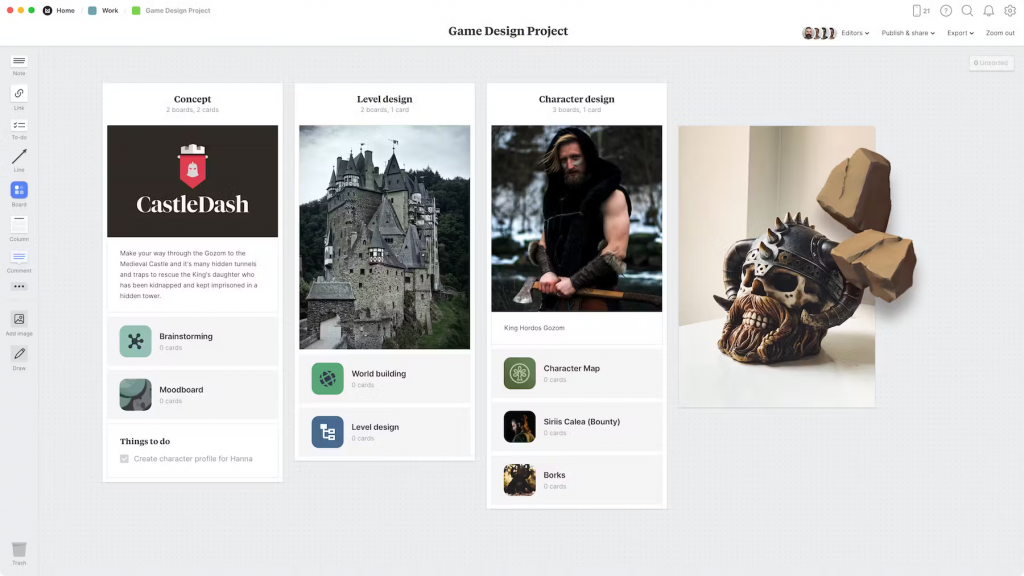
Authorship and Maintenance of the GDD
Typically, the lead game designer drafts the initial versions of a GDD. The lead game designer’s role extends beyond just writing. They are responsible for synthesizing, organizing, and filtering ideas to create a cohesive vision that aligns with the project’s overall vision.
Yet, developing a GDD is not a task for a single person. It’s a shared responsibility. Input from the entire design team is essential to ensure the cohesiveness of the document. After all, the GDD serves as a reference point, so-called, roadmap for the entire team.
Who reads the GDD?
The GDD isn’t solely for the perusal of game designers. Quite the opposite. It’s meant to be read by all members of the development team, including:
- Designers
- Artists
- Programmers
- Sound designers
- Producers
- QA testers
- Stakeholders
The GDD offers a clear and comprehensive overview of the game’s design and development, ensuring that all team members share a common understanding of the game’s vision, mechanics, and goals. This shared understanding is vital for aligned decision-making and clear communication throughout the game design project. Programmers find it helpful in organizing development tasks, monitoring progress, establishing milestones, and managing resources efficiently.
Necessity of a Game Design Document for Every Game
But what we should know is that a GDD is not necessary for every game. It is utilized when the game concept becomes too complex to be mentally retained and when there is a need to communicate intricate aspects of the game to others effectively.
For larger game development projects, a GDD offers numerous benefits. It keeps the team aligned, ensures clear communication, and is a crucial reference point throughout game-building. Neglecting to have a GDD for a large project can lead to frequent changes, a disorganized development framework, unfulfilled producer expectations, and various other negative impacts on the game development process.
On the other hand, for smaller projects or uncomplicated games with direct mechanics, a GDD may not be necessary. In such cases, informal approaches such as prototyping might be used.
Various Formats for Game Design Documents
GDDs can adopt diverse formats, like traditional written documents or game design wikis depending on the project specifics and team preferences. A traditional game document is a comprehensive blueprint, encompassing elements such as the narrative, game mechanics, art style considerations, and crucial game features.
Conversely, a game design wiki acts as a cooperative platform where game designers can write a game design, record and disseminate their ideas, concepts, and game creation rules, facilitate teamwork, and allow multiple team members to contribute to the design document.
Traditional Written Game Design Documents
Traditional written GDDs, characterized by their comprehensive and detailed nature, provide a meticulous master checklist for game development, bringing clarity and precision. However, they may lack flexibility for updates and can be more challenging to maintain compared to other formats.
Creating a traditional written GDD involves the meticulous crafting of a comprehensive and organized document. This document then functions as a central reference point and directs the game development process. It furnishes programmers and artists with the requisite details for executing the game.
Utilizing a Game Design Wiki
Conversely, game design wikis offer a more flexible and collaborative approach to game design documentation. They allow multiple individuals to access and modify shared information, thereby supporting the development and upkeep of a GDD through collective contribution and revisions.
Collaborative design tools that can be used for creating a GDD include:
- Wikis
- Trello
- Slack
- Notion
These tools offer streamlined organization within a development team, improved accessibility and comprehension for novice designers, and the rapid capture and sharing of ideas.
The Concise One-Page Game Design Document
The concise one-page GDD is another format deserving of mention. These GDDs are characterized by their conciseness and visual focus. They effectively convey core ideas and information in a compact format.
The one-page game design document template approach emphasizes the effective communication of a specific concept through the use of illustrations, charts, or maps, supplemented with callout information to visually and succinctly describe game features, mechanics, or levels on a single page.
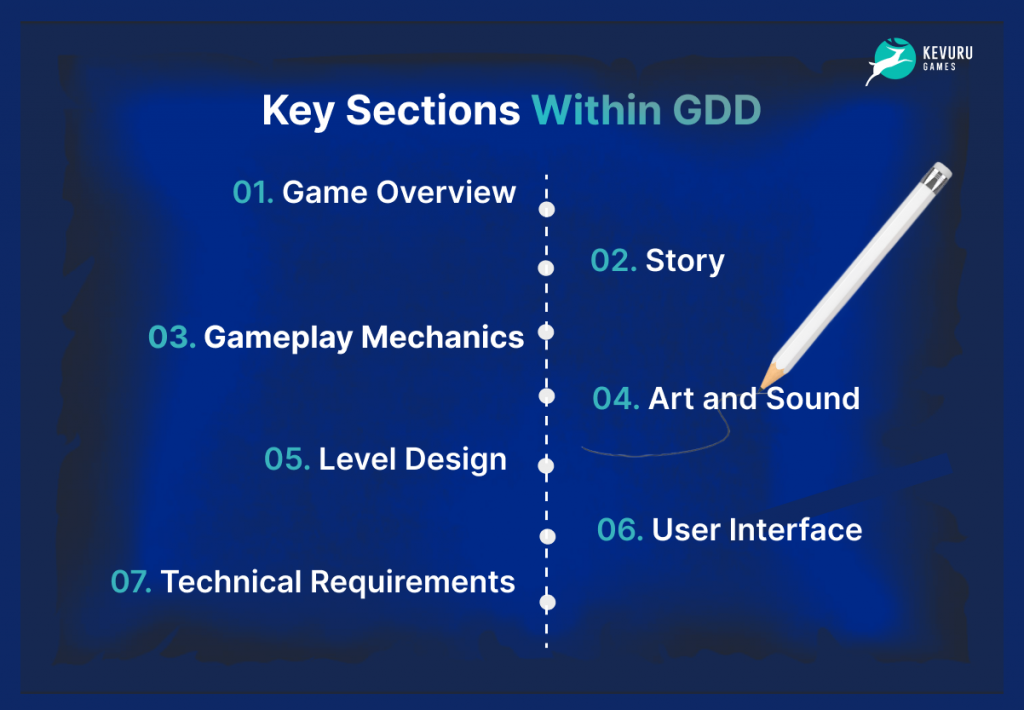
Key Sections within a Game Design Document
No matter the format, a GDD game design document consists of several essential sections. These include:
- Game overview
- Story
- Gameplay mechanics
- Art and sound components
- Level design
- User interface
- Technical requirements
The game overview section offers a high-level summary of the game’s core features and objectives.
The story section outlines the game’s narrative, characters, and settings. Begin with a brief summary of the plot, highlighting the main story beats, and then proceed to offer more comprehensive details about the characters and settings. The gameplay mechanics section should offer a comprehensive analysis of the game’s mechanics, controls, and user interface. It should elucidate the player-game interaction and the anticipated user experience.
Overview of the Game
The game overview section commonly includes:
- The game’s selling points
- Target audience
- Genre
- Benchmark examples
- Platforms
Defining the target audience is crucial as it guides various design decisions, ensuring that the game resonates with its intended players.
Details about the platforms on which the game will be available are also important to include as this information can have implications for design, development, and marketing strategies. Reference examples are included to provide the development team with a comprehensive understanding of the game’s style, gameplay, and mechanics, and to establish a standard for quality and design decisions.
Story
In a GDD’s story section, it’s recommended to sketch out the game’s plot, characters, and settings. A compelling narrative encompasses detailed depictions of the setting, characters, and storyline, in addition to defining the tone, aesthetic, target demographic, and design principles to uphold coherence with the game’s fundamental vision.
The characters and settings in the story section should exhibit depth and clarity, supported by detailed information that contributes to the game’s storyline and their significance within the game world. The level of detail should also align with the genre of the game.
Gameplay Mechanics
Gameplay mechanics include the techniques players use to interact with the game’s world and systems, the corresponding feedback from those systems based on the player’s actions, and various elements, including visuals, sounds, animations, physics, and others. The controls section within the Gameplay segment should elucidate the methods through which players will engage with the game and execute diverse actions. The objectives section should encompass both short-term goals within each level and overarching goals that span the entire game, along with the core gameplay loop that players will engage with repeatedly.
It is advisable to provide a detailed description of the unique mechanics and features that distinguish the game, along with an explanation of the game’s progression systems, to ensure a comprehensive understanding of how the game evolves and maintains player engagement.
Art and Sound Components
Components of art and sound encompass:
- Visual and auditory style
- Character design
- Environmental aesthetics
- Music style
These components frequently incorporate concept art and references. Concept art plays a crucial role in providing readers with an understanding of the overarching art direction for the game. It serves as a visual representation that communicates the artistic vision and aids in shaping the development of game aesthetics.
Detailed notes and sketches are essential to establish the identities and roles of the characters in the game. A character web that illustrates their relationships could be included in cases involving multiple characters. Visual representations are crucial in conveying the characters’ personalities and interactions within the game.
The sound section of a GDD should delineate the game’s musical style and any specific themes or motifs that need to be incorporated.
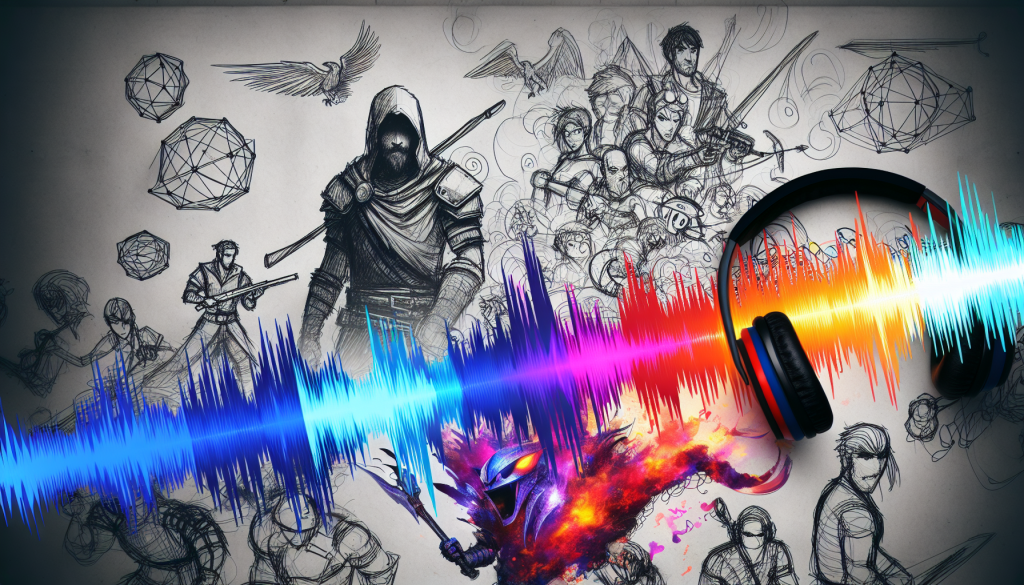
Level Design Specifications
The Level Design section usually includes:
- The arrangement and order of levels
- Objectives
- Environmental hazards
- Challenges
This section provides a comprehensive guide for integrating the level and guarantees alignment with the game’s narrative and visual design.
Maps and early ‘pencil and paper’ mock-ups are essential in providing a comprehensive understanding of the level’s layout, allowing for more precise visualization of the game levels, even from perspectives the player may not experience in the actual game. These tools are just a starting point for the development process, ensuring a solid foundation for the final product.
User Interface (UI) Details
In a GDD, the UI section outlines menus, HUD, inventory, and game systems, ensuring consistency with the game’s theme and art style. The components encompassed within a game’s UI typically consist of:
- Diegetic elements
- Non-diegetic elements
- Spatial elements
- Meta elements
Maintaining consistency with a game’s theme and art style is crucial in UI design as it promotes visual harmony and cultivates a feeling of unity and recognition across the game.
The HUD should be user-friendly, subtle, and customized to meet the unique requirements of each game and platform. When creating the HUD for a game, it is crucial to take into account elements such as mini-maps, health bars, and other items that assist the player.
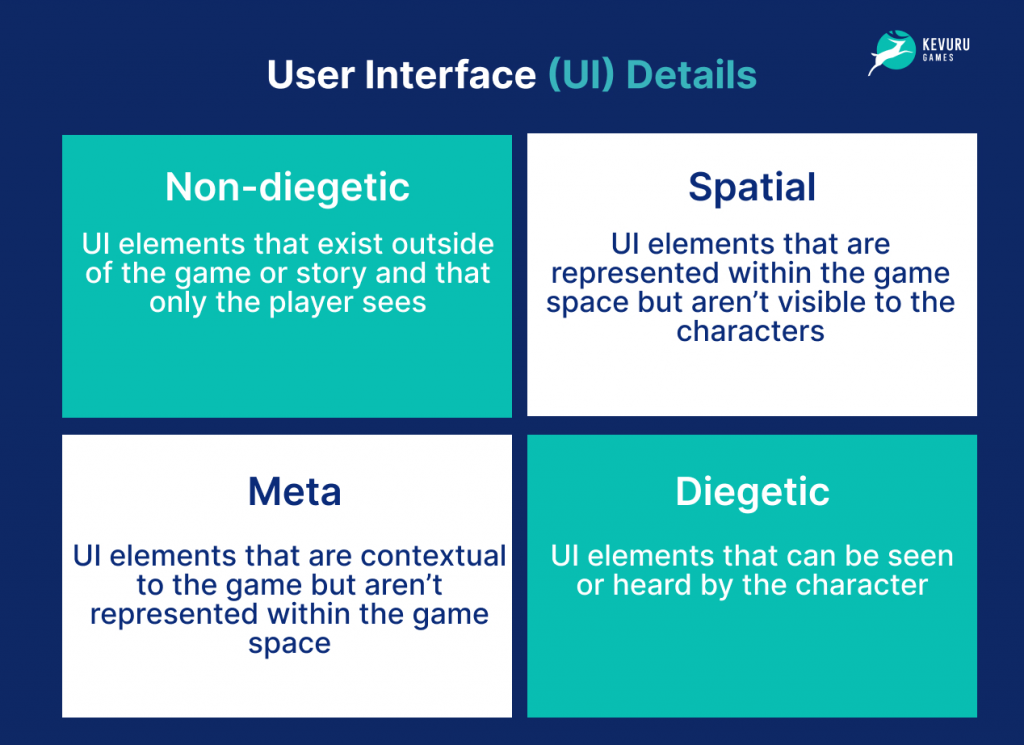
Technical Requirements
The GDD’s Technical Requirements section furnishes specifics on necessary hardware, software, engine requirements, and any required third-party software, plugins, or middleware for the project. This section ensures that the development team possesses a comprehensive understanding of the technical specifications needed to develop and execute the game. Typical hardware requirements in a game design document encompass supported platforms like PC, console, mobile devices, and any necessary hardware components crucial for the game’s intended functionality.
Structuring a Game Design Document
Organizing a GDD entails arranging content into sensible sections like:
- Team introduction
- Title page
- Genre classification
- Mechanics overview
- Detailed storyline
- Project status report
This organization is crucial for the document’s readability and ensures that all the important elements of the game design are adequately covered.
Page 1: Introduction to the TeamPage
The introduction to the team page in a GDD is important because it:
- Introduces the team members to each other
- Helps them understand each other’s roles and responsibilities
- Fosters collaboration and promotes effective communication
- Integrates gamification elements to stimulate teamwork
- Clarifies roles and responsibilities
- Institutes norms and processes for streamlined workflow
2: Title page
The title page of a GDD generally includes the game’s name, a relevant visual, and other pertinent details that identify the project. This page is particularly important as it establishes the game’s identity and sets the tone for the rest of the document.
Page 3: Genre Classification
Genre classification in a GDD involves defining the game genre and flavor by categorizing the game into specific genres such as action, adventure, simulation, shooter, etc.
Page 4: Mechanics Overview
The mechanics overview in a GDD encompasses the fundamental gameplay elements, providing detailed information on the controls, player interactions, and unique gameplay experiences that players will encounter. This overview offers a concise summary of the game’s essence, while refraining from delving into intricate specifics of game mechanics.
Page 5: Comprehensive Storyline
In the storyline section, it is advisable to outline the game’s narrative, characters, and settings. Begin with a brief plot summary, highlighting the main story beats, and then offer more comprehensive details about the characters and settings.
Page 6: Project Status Report
A Project Status Report holds significant importance in the overall game development process by providing stakeholders with updates on the progress, milestones achieved, and any issues or risks encountered in the project. It is a vital tool for monitoring the project’s health and mitigating potential failures.
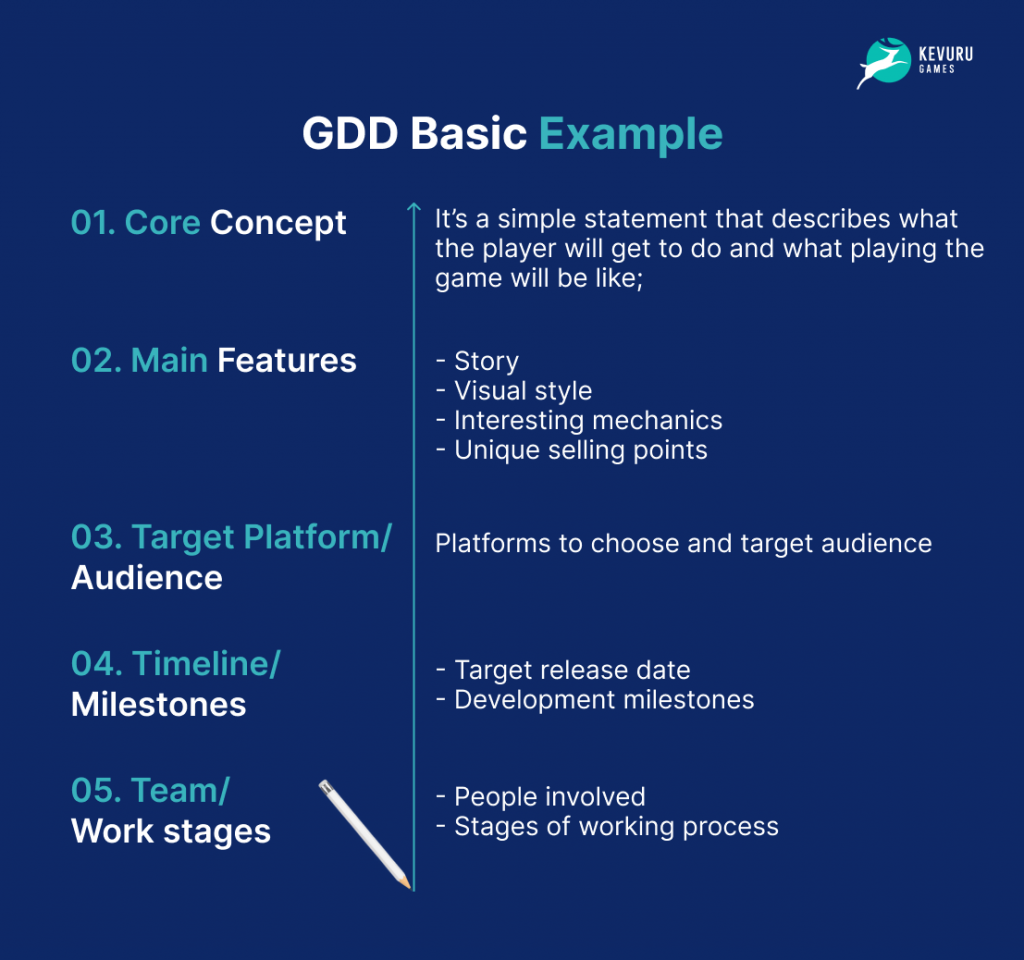
Kevuru Games Expertise in Level Design Documentation
Kevuru Games game level design studio is proficient in level design documentation, has delivered successful projects involving:
- Genre
- Setting
- The target audience
- Unique selling points
- Examples of similar games
- Platform
- Plot
- Description of mechanic
- Game engine
- Game mechanics
- Graphics and sound requirements
- Monetization model
Kevuru Games meticulously oversees every aspect of game level design, crafting comprehensive documentation to establish a well-organized GDD that upholds coherence in the gaming experience.
Summary
We tried to give you an expert idea of how to make a game design document that corresponds to requirements for GDD to serve as a roadmap for the team and a reference for stakeholders.
- A Game Design Document (GDD) is a foundational tool in game development that details game elements and guides all team members through design and development, often incorporating visual aids like flowcharts and maps.
- The GDD should be maintained collaboratively, usually initiated by the lead game designer but requiring input from the whole team for cohesion, and consulted by a diverse group of team members including programmers, artists, and stakeholders.
- GDDs can vary in format ranging from traditional comprehensive documents to flexible wikis and concise one-pagers, and should include key sections such as an overview, story, gameplay mechanics, art and sound, level design, user interface, and technical requirements.











